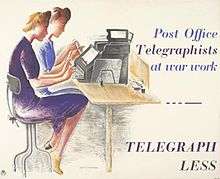Donia Nachshen
Donia Esther Nachshen (22 January 1903 – 1987) was a Ukrainian-born British book illustrator and poster artist who is now best known for the posters she produced for the British government during World War Two.[1]
Donia Nachshen | |
|---|---|
| Born | Donia Esther Nachshen 22 January 1903 |
| Died | 1987 (aged 83–84) |
| Nationality | British |
| Education | Slade School of Fine Art |
| Known for | Illustration and poster art |
Biography

Nachshen was born in the city of Zhitomir, which was then part of Russia and is now in the Ukraine. Nachshen was born into a Jewish family and after an anti-Jewish pogrom in the city in 1905, the family fled Zhitomir and eventually settled in London. Nachshen did well at school in London and enrolled in the Slade School of Art.[1] By the 1920s she had established herself as a successful book designer.[2] She illustrated translations of works by Arthur Schnitzler and the Nobel Prize winner Anatole France in a style based on Russian folk art and art deco elements.[3][4] Nachshen also illustrated a version of the Jewish text the Haggadah in 1934 and also illustrated editions of works by Oscar Wilde and Samuel Butler.[5] She also produced illustrations for the Radio Times.[6]
During World War Two, Nachshen produced poster designs for a number of high-profile campaigns, notably the Make Do and Mend campaign run by the Board of Trade and also Telegraph Less for the General Post Office. She continued with her book illustration work during the War, producing designs for versions of Diary of a Madman by Nikolai Gogol and a 1945 collection of short stories by Feodor Dostoyevsky as well as books by Enid Blyton.[7] After the War, Nachshen lived in London and continued to illustrate Russian novels and poetry, mainly for the publishers Constable & Co and also for the Lindsay Drummond company.[1] For the Russian novels, Nachshen used scraperboard to create dramatic illustrations that resembled a style of eastern European woodcuts, while for the children's book that she illustrated she used much lighter pen drawings.[7]
Books illustrated
Books illustrated by Nachshen include,[7][2]
- The Works of Anatole France by Anatole France, (Bodley Head, 1925)
- Topsy Turvey by V. Bartlett, (1927)
- Rhapsody by Arthur Schnitzler, (Constable, 1928)
- Fraulein Else by Arthur Schnitzler, (Constable, 1929)
- The Red Lily by Anatole France, (Bodley Head, 1930)
- The Haggadah (1934)
- The Way of All Flesh by Samuel Butler, (Cape, 1936)
- Enid Blyton's Nature Lover's Book by Enid Blyton, (Evans Brothers, 1944)
- Black Night, Red Morning by Geoffrey Trease, (1944)
- Diary of a Madman / Nevsky Prospekt by Nikolai Gogol, (Drummond, 1945)
- Three Tales by Fyodor Dostoyevsky, (Drummond, 1945)
- The Spirit of Music by Alexander Blok, (Drummond, 1946)
- Tales of Bielkin by Alexander Pushkin, (Drummond, 1947)
- Pushkin, Lermontov, Tyutchev; Poems (Drummond, 1947)
- Out of Childhood by I. Odoertzera, (Constable)
- Poems in Prose by Ivan Turgenev, (Drummond)
References
- Richard Slocombe (2014). British Posters of the Second World War. Imperial War Museum. ISBN 978-1-904897-92-7.
- Simon Houfe (1996). The Dictionary of 19th Century British Book Illustrators. Antique Collectors' Club. ISBN 1 85149 1937.
- The Collection Online. "She has taken great pains in honor of her husband's memory, who was said to loved Italian art". Metropolitan Museum of Art. Retrieved 17 February 2016.
- The Collection Online. "While he was talking of every-day matters, her mind was in a reverie far away". Metropolitan Museum of Art. Retrieved 18 February 2016.
- Dr Bex Lewis (24 January 2010). "Donia Nachshen". drbexl.co.uk. Retrieved 17 February 2016.
- "Christmas Eve". Radio Times (429): 916. 18 December 1931.
- Alan Horne (1994). The Dictionary of 20th Century British Book Illustrators. Antique Collectors' Club. ISBN 1 85149 1082.
External links
| Wikimedia Commons has media related to Donia Nachshen. |
- Works by Donia Nachshen in the Imperial War Museum collection.